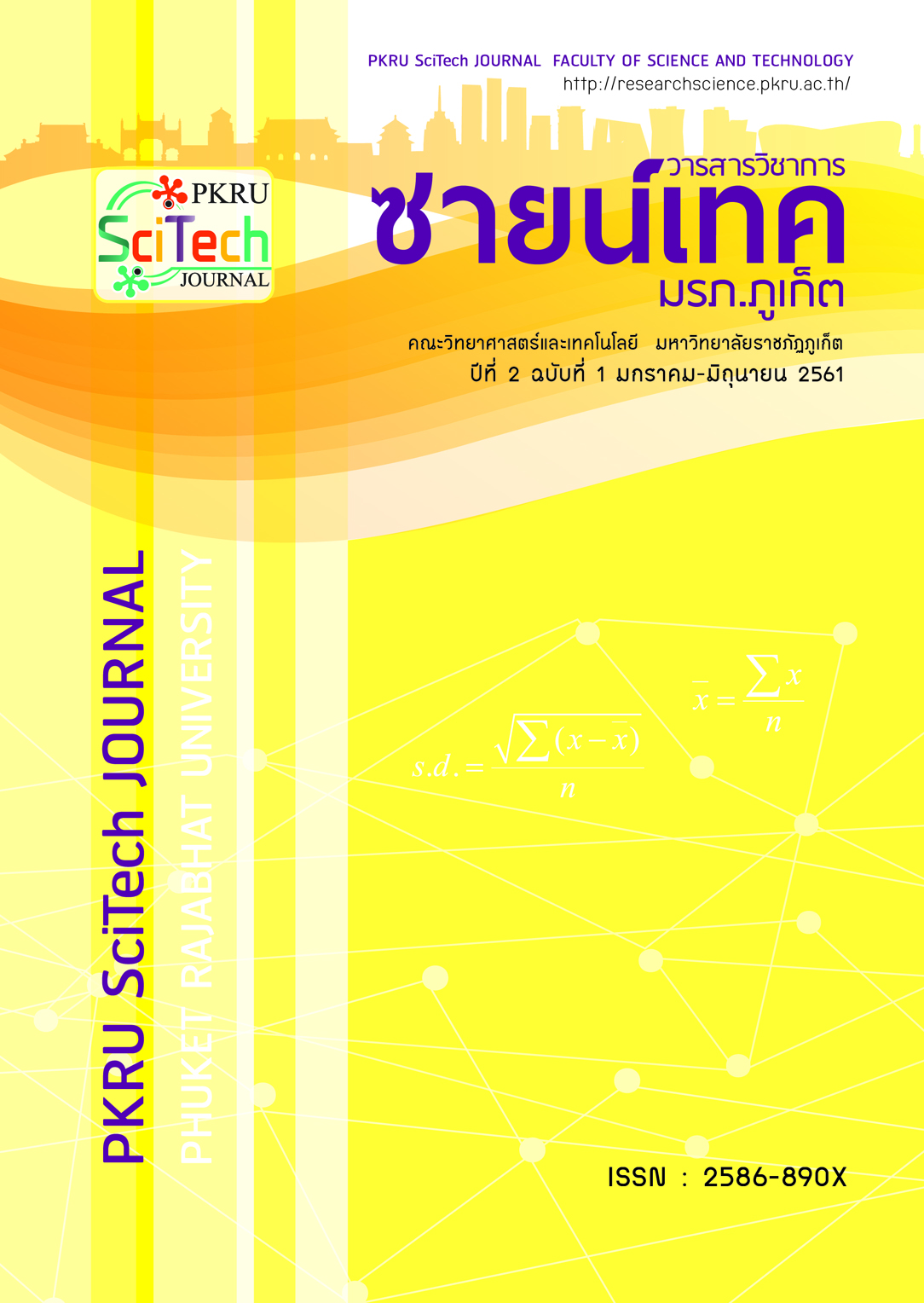การพัฒนาแบบจำลองสารสนเทศสามมิติเชิงแนะนำสำหรับผลิตภัณฑ์ฟาร์มเกษตรด้วยเทคโนโลยีความเป็นจริงเสมือน
Main Article Content
Abstract
งานวิจัยนี้เป็นงานวิจัยเชิงทดลองโดยนำเทคโนโลยีความเป็นจริงเสมือนมาประยุกต์ใช้แนะนำผลิตภัณฑ์ฟาร์ม เกษตรในรูปแบบจำลองสามมิติ กลุ่มตัวอย่างถูกคัดเลือกด้วยวิธีการสุ่มแบบเจาะจง เพื่อทำการทดสอบและประเมินผลงานวิจัย โดยเครื่องมือที่ใช้ในงานวิจัย ได้แก่ แบบสอบถาม เครื่องมือทางสถิติและ ซอฟท์แวร์ประยุกต์ เอ อาร์ ยูนิตี้ (AR Unity) ซึ่งผลการทดสอบโดยใช้เกณฑ์การทดสอบและผู้เชี่ยวชาญพบว่า (1) ผลการทำงานของมาร์คเกอร์แบบจำลองอยู่ในระดับดีมาก มีค่าเฉลี่ย 4.87 และค่าเบี่ยงเบนมาตรฐาน 0.35 (2) ผลการทำงานของการสร้างโมเดล ฟาร์มเกษตร อยู่ในระดับดีมาก มีค่าเฉลี่ย 4.83 และค่าเบี่ยงเบนมาตรฐาน 0.38 และ (3) ผลการทำงานของแอพพลิเคชั่น AR Unity สามารถมองเห็นโมเดลฟาร์มเกษตร ในรูปแบบโมเดล 3 มิติ อยู่ในระดับดีมาก มีค่าเฉลี่ย 4.73 และค่าเบี่ยงเบนมาตรฐาน 0.52 นอกจากนี้ผู้วิจัยพบว่าการนำเอาเทคโนโลยีความเป็นจริงเสมือนมาประยุกต์ใช้ในฟาร์มเกษตรสามารถสร้างความพึงพอใจให้แก่เจ้าของธุรกิจและผู้ใช้งานทั่วไปเป็นอย่างดี โดยมีผลคะแนนเฉลี่ยความพึงพอใจในระดับดี (ค่าเฉลี่ย 4.28 และค่าเบี่ยงเบนมาตรฐาน 0.60) ประโยชน์ที่ได้รับจากงานวิจัยครั้งนี้สามารถนำไปใช้ขยายผลองค์ความรู้ด้านการพัฒนาสื่อสารสนเทศที่ทันสมัยต่อไปในอนาคต
Article Details
- The original content that appears in this journal is the responsibility of the author excluding any typographical errors.
- The copyright of manuscripts that published in PKRU SciTech Journal is owned by PKRU SciTech Journal.
References
[2] Billinghurst, M., Clark, A., & Lee, G. (2015). A survey of augmented reality. Foundations and Trends® in Human – Computer Interaction, 8(2-3), 73-272.
[3] Amin, D., & Govilkar, S. (2015). Comparative study of augmented reality Sdk’s. International Journal on Computational Science & Applications, 5(1), 11-26.
[4] Jung, T., Chung, N., & Leue, M. C. (2015). The determinants of recommendations to use augmented reality technologies: The case of a Korean theme park. Tourism
management, 49, 75-86.
[5] Liao, T. (2015). Augmented or admented reality? The influence of marketing on augmented reality technologies. Information, Communication & Society, 18(3), 310-326.
[6] Brohm, D., Domurath, N., Glanz-Chanos, V., & Grunert, K. G. (2017). Future trends of augmented reality. In Augmented reality for food marketers and consumers (pp.1681-1685). Wageningen Academic Publishers.
[7] Parfenov, V., Jordan, K. E., Dertien, S. T., Baum, M. J., Gosselin, A., Prideaux-Ghee, S., & Heppelman, J. E. (2016). U.S. Patent Application No. 15,146,398.
[8] Grampurohit, S. D., Hazlewood, W. R., Harrison, B. L., & Consolvo, S. A. (2016). U.S. Patent No. 9,406,170. Washington, DC: U.S. Patent and Trademark Office.
[9] Hagbi, N., Bergig, O. Y., & Elsana, J. A. (2017). U.S. Patent No. 9, 824,495. Washington, DC: U.S. Patent and Trademark Office.
[10] Azuma, R., Hoff, B., Neely, H., & Sarfaty, R. (1999). A motion-stabilized outdoor augmented reality system. In Virtual Reality, 1999. Proceedings., IEEE (pp. 252-259). IEEE.
[11] Rehman, U., & Cao, S. (2017). Augmented-reality-based indoor navigation: a comparative analysis of handheld devices versus google glass. IEEE Transactions on Human-Machine Systems, 47(1), 140-151.
[12] Xing, Z. T., Zhou, D. T., Zhou, T. T., & Zhou, A. H. (2017). U.S. Patent Application No. 29/587, 752.


